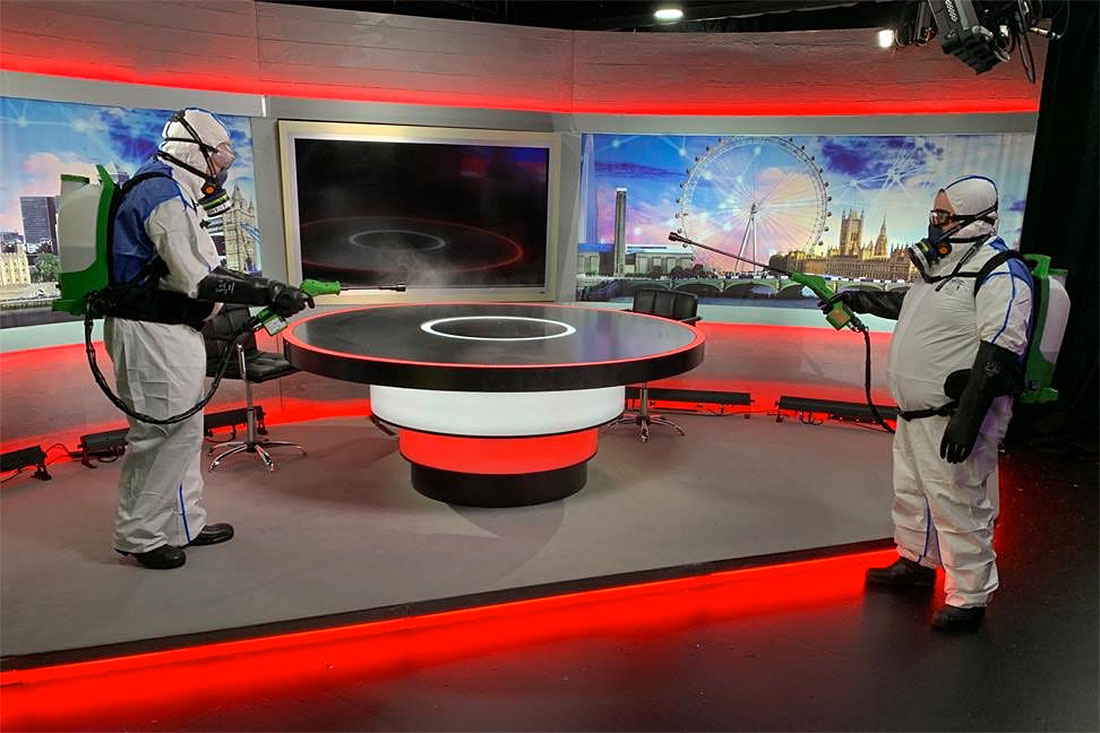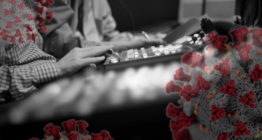Disinfecting and cleaning methods for broadcast studios and equipment

Subscribe to NCS for the latest news, project case studies and product announcements in broadcast technology, creative design and engineering delivered to your inbox.
While many broadcasters never completely abandoned their studios for at-home sets due to the coronavirus, some have implemented new protocols for cleaning and social distancing on set.
As states begin to reopen in the U.S., we look at a few of the recommended ways to clean and disinfect broadcast studio spaces, taking into account the unique materials and electronic components present.
No Admittance Areas
Of course, day to day life at broadcast facilities is different now. Tim Saunders of Broadcast Design International notes the changes are sweeping.
A network O&O client of theirs has created a sealed “break glass in case of an emergency” studio and control room. The broadcaster has also set up office trailers in the building’s basement to help separate essential staff inside the facility.
Stages, control rooms, anchor desks, chairs, keyboards, operational surfaces are all sanitized after every hit or change of talent and operational personnel, Saunders notes of the client.
Workers like makeup artists are now wearing N95 masks and gloves, with hand sanitizer and sanitary wipes becoming a standard operating procedure.
Set Surfaces
Modern broadcast set design mixes a variety of laminates, metals and acrylics.
Each of these surfaces provides a new potential home for the coronavirus (or a host of other germs), with some parts of a set seeing regular surface contact from talent.
For plexiglass or acrylic, which is likely one of the most touched surfaces on a set, Mack McLaughlin of FX Design Group recommends Brillianize.
The cleaner, which is specially designed for usage with plastics, can eliminate up to 99% of bacteria according to a study from University of California, Davis.
Regular window cleaners with ammonia (like Windex or 409) can break down the material and cause a cloudy fog, notes Diane Fiolek of Devlin Design Group.
Laminates on set can be disinfected with wipes; however, it’s recommended to test first in an off-camera spot first to ensure no lasting or visible changes.
CounterTop Magic is also an option, specially formulated for laminate and solid surface countertops.
With all cleaners on set, microfiber cleaning cloths are recommended over paper towels.
McLaughlin also notes, “When in doubt of damaging the material, warm soapy water is probably the safest bet.”
Studio Cameras and Equipment
For high-touch electronics made of plastic, Sony Electronics “generally recommends using ethanol (76.9-81.4% by volume) as a cleaning agent, dampening a soft cloth made of cotton, such as gauze, and wiping the product’s surface lightly once.”
In a statement to NewscastStudio, Sony did caution, however, that there are exceptions.
“Certain surfaces – such as clear plastic, camera lenses and monitor screens – could be damaged by ethanol or other harsh chemical cleansers. For these surfaces, it’s better to use non-chemical cleaning methods.”
Electrostatic Cleaning
Generally speaking, spraying to clean is not a good idea as it can cause germ particles to go airborne.
The one exception is electrostatic cleaning, where a cleaning agent is sprayed as an electrically charged mist that aggressively adheres to surfaces and objects.
Some broadcasters, such as Celebro Media in London and major O&Os in New York City, have opted to invest in electrostatic cleaning for its studios.
Through spraying, a larger surface area can be covered in a quicker timeframe. Some studies also note the effects of electrostatic cleaning can last upwards of 25 plus days on a surface, making it useful for high-traffic areas.
Normalcy will return, but until then, vigilance and proper cleaning can ensure a safe working environment for broadcast professionals.
Subscribe to NCS for the latest news, project case studies and product announcements in broadcast technology, creative design and engineering delivered to your inbox.






tags
cleaning, Coronavirus, diane fiolek, mack mclaughlin, Sony, Tim Saunders
categories
Broadcast Engineering, Broadcast Equipment, Broadcast Industry News, Heroes, Set Design